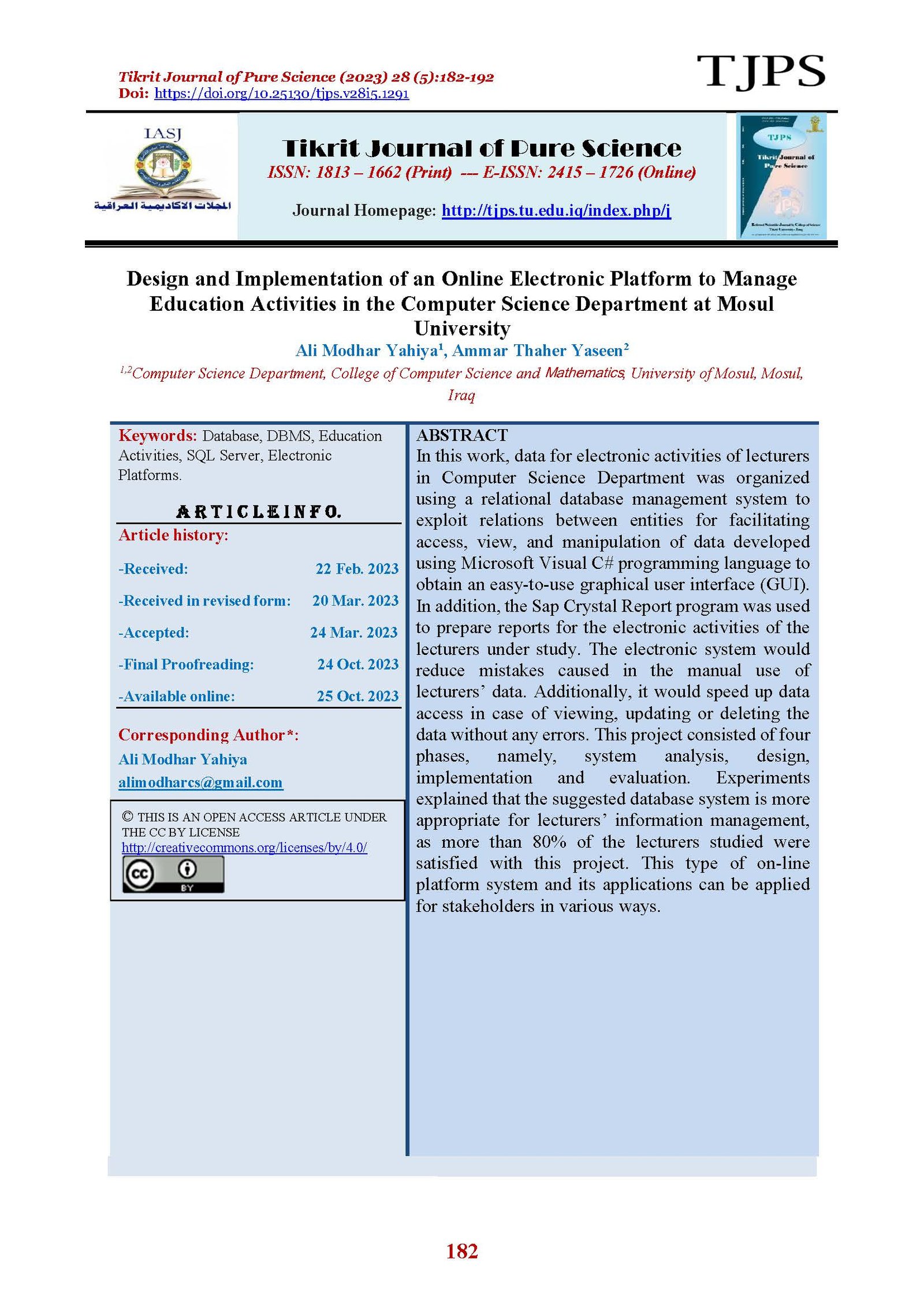Design and Implementation of an Online Electronic Platform to Manage Education Activities in the Computer Science Department at Mosul University
Main Article Content
Abstract
In this work, data for electronic activities of lecturers in Computer Science Department was organized using a relational database management system to exploit relations between entities for facilitating access, view, and manipulation of data developed using Microsoft Visual C# programming language to obtain an easy-to-use graphical user interface (GUI). In addition, the Sap Crystal Report program was used to prepare reports for the electronic activities of the lecturers under study. The electronic system would reduce mistakes caused in the manual use of lecturers’ data. Additionally, it would speed up data access in case of viewing, updating or deleting the data without any errors. This project consisted of four phases, namely, system analysis, design, implementation and evaluation. Experiments explained that the suggested database system is more appropriate for lecturers’ information management, as more than 80% of the lecturers studied were satisfied with this project. This type of on-line platform system and its applications can be applied for stakeholders in various ways.
Article Details

This work is licensed under a Creative Commons Attribution 4.0 International License.
Tikrit Journal of Pure Science is licensed under the Creative Commons Attribution 4.0 International License, which allows users to copy, create extracts, abstracts, and new works from the article, alter and revise the article, and make commercial use of the article (including reuse and/or resale of the article by commercial entities), provided the user gives appropriate credit (with a link to the formal publication through the relevant DOI), provides a link to the license, indicates if changes were made, and the licensor is not represented as endorsing the use made of the work. The authors hold the copyright for their published work on the Tikrit J. Pure Sci. website, while Tikrit J. Pure Sci. is responsible for appreciate citation of their work, which is released under CC-BY-4.0, enabling the unrestricted use, distribution, and reproduction of an article in any medium, provided that the original work is properly cited.
References
[1] Abed, E. K. (2019). Electronic learning and its benefits in education. EURASIA Journal of Mathematics, Science and Technology Education, 15(3), https://doi.org/10.29333/ejmste/102668
[2] Sathishkumar, V., Radha, R., Saravanakumar, A., & Mahalakshmi, K. (2020). E-learning during lockdown of Covid-19 pandemic: A global perspective. International Journal of Control and Automation, 13(4), 1088-1099.
[3] Foster, I. & Pascal, H. (2020). Databases. In I. Foster et al. (eds), Big Data and Social Science: Data Science Methods and Tools for Research and Practice, 2nd Ed. New York: Chapman & Hall/CRC, pp. 67-99.
[4] Al Abd Alazeez, A. T. (2022). Streaming database system for deaf people. NTU Journal of Engineering and Technology, 1(3), 41-48. https://doi.org/10.56286/ntujet.v1i3.154
[5] Seybold, D., Keppler, M., Gründler, D., & Domaschka, J. (2019). Mowgli: Finding your way in the DBMS jungle. International Conference on Performance Engineering (ICPE ’19), pp. 321-332, 7-11 April.
[6] Al Abd Alazeez, A. T. (2022). Managing streaming database system for education by using partial replication approach to update the database. Mosul, Iraq: Future Studies Center, Al-Hadba University College, pp. 1-20.
[7] Al Abd Alazeez, A. T. (2021). DED: Drift principle in educational evolved data. Tikrit Journal of Pure Science, 26(2), 118-125.
[8] Vora, M., Barvaliya, H., Balar, P., & Jagtap, N. (2020). E-learning systems and MOOCs: A review. International Journal for Research in Applied Science & Engineering Technology (IJRASET), 8(IX), 636-641. 10.22214/ijraset.2020.31532.
[9] Liu, Z., Lomovtseva, N., & Korobeynikova, E. (2020). Online Learning Platforms: Reconstructing Modern Higher Education. International Journal of Emerging Technologies in Learning (iJET), 15(13), 4-21. DOI:10.3991/ijet.v15i13.14645
[10] Cabero-Almenara, J., Arancibia, M. L. & del Prete, A. (2019). Technical and didactic knowledge of the Moodle LMS in higher education: Beyond functional use. Journal of New Approaches in Educational Research (NAER Journal), 8(1), 25-33. https://doi.org/10.7821/naer.2019.1.327
[11] Kraleva, R., Sabani, M., Kralev, V., & Kostadinova, D. (2020). An approach to designing and developing an LMS framework appropriate for young pupils. International Journal of Electrical & Computer Engineering (IJECE), 10(2), 1577-1591. DOI: http://doi.org/10.11591/ijece.v10i2.pp1577-1591
[12] Mulyani, S. (2019). Systems analysis and design methods. Indonesia, Jatinangor: Unpad Press.
[13] Demba, M. (2013). Algorithm For Relational Database Normalization Up To 3NF. International Journal of Database Management Systems (IJDMS), 5(3), 39-51. DOI:10.5121/ijdms.2013.5303
[14] Kepner, J., Gadepally, V., Hutchison, D., Jananthan, H., Mattson, T., Samsi, S., & Reuther, A. (2016). Associative array model of SQL, NoSQL, and new SQL databases," 2016 IEEE High Performance Extreme Computing Conference (HPEC), IEEE, pp. 1-9.
[15] Aljaloud, S. (2023). Performance refinement of convolutional neural network architectures for solving big data problems. Tikrit Journal of Pure Science, 28(1), 89–95. https://doi.org/10.25130/tjps.v28i1.1270
